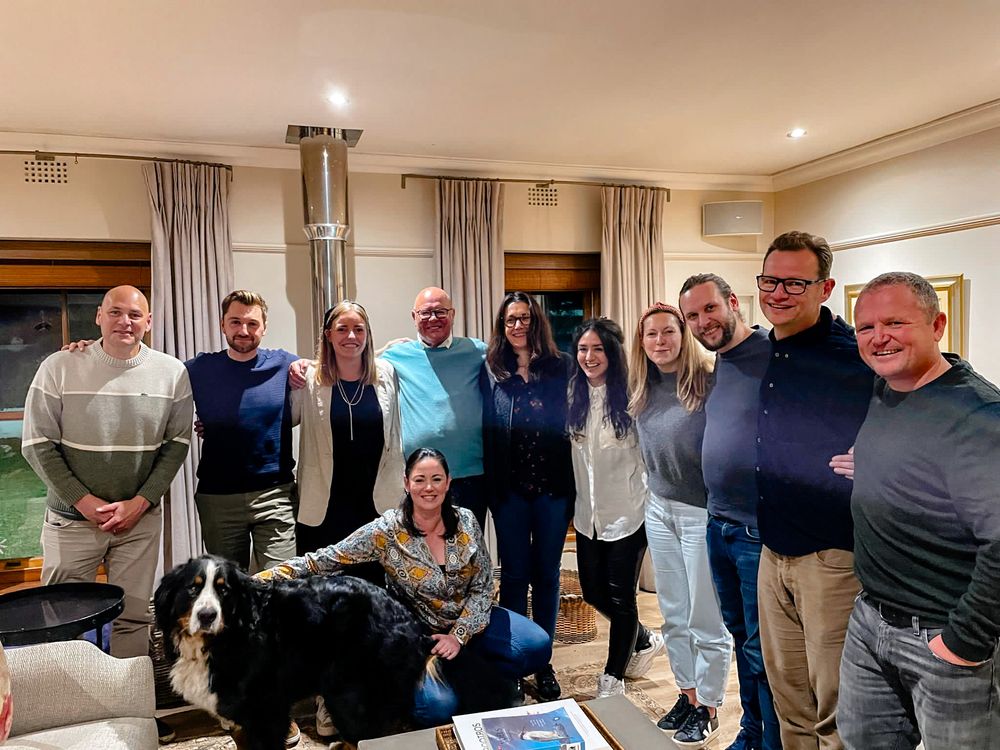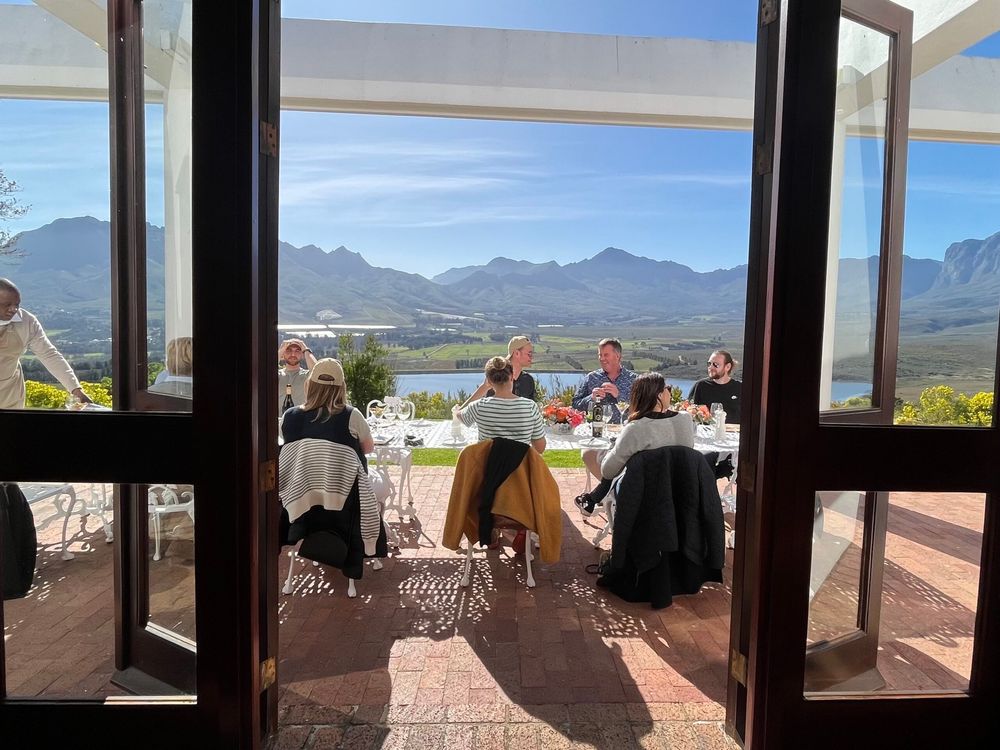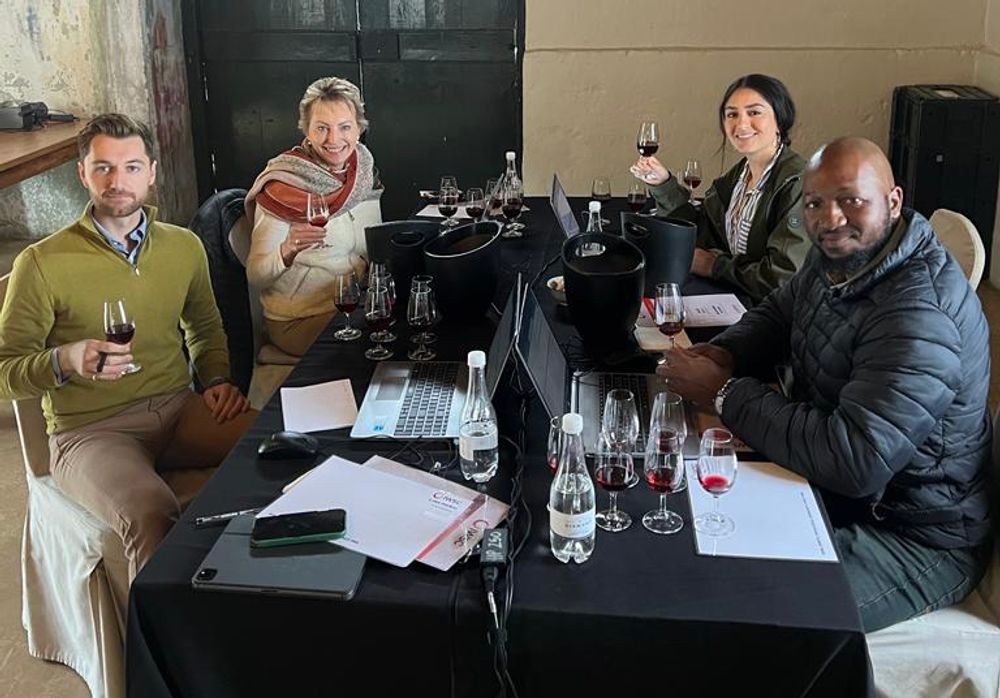We continue our series looking at IWSC’s new initiative to take its judging on the road by assessing how South Africa, its wines and producers performed.
The IWSC handpicked a team of judges who could provide a wide lens with which to consider the entries this year, including buyers, sommeliers and communicators, to join the local South African judges in Paarl. Making up the UK contingent, there was Maggie Macpherson from Jeroboams, Samantha Glanfield from Sainsbury’s, Colin Thorne from Vagabond, Luke Harbor from The Pig Hotels and myself, representing the wine communications angle, with IWSC judging committee member, Dirceu Vianna Junior MW, overseeing proceedings.

The IWSC judging team on a visit to Kanonkop
Including the wines that were judged in London earlier in the year, South Africa bagged a total of 570 medals, achieving 18 gold medals and 190 silver medals. It was the international grape varieties that stood out the most, with Chardonnay wines being awarded five golds and Cabernet Sauvignon winning four.
A look at the whites
The top-scoring Chardonnays were from a range of regions and vintages, the newest being 2022 and the oldest being 2023. All the wines were oaked, between 13% and 13.5% abv, which, I think, demonstrates deftly-honed know-how in working with the material produced by the climate and the terroir. South Africa will never be a region that produces light, low alcohol Chardonnays, but even with this ripeness, you’re still getting profound freshness and balance. A common point of praise across these award-winning wines was the subtle and expert use of oak, which brought weight and roundedness to those fresh, clean, fruity grapes.
Even though it was a glittering party for Chardonnay, the highest scoring white of all was actually a Sauvignon Blanc, Semillon blend, the Kanonberg 2017 from Bloemendal Wine Estate, which achieved 96 points. My panel had the pleasure of judging this wine, noting: “Lovely, rich, golden colour. The nose is enticing and shows a level of evolution. The palate is layered and complex with an abundance of fruits, honey, spice, nuts and a beautiful minerality. Poised and elegant with a long finish.”
Turning to the reds

Le Grande’s Domaine head of wine Debbie Thompson says it is exciting to work with Cabernet Sauvignon in Stellenbosch
“Stellenbosch Cabernet is King,” said Le Grand Domaine winemaker, Debbie Thompson, when we visited the estate on our trip. “It’s got the right terroir, the right climate and the right planting material.”
Of the gold medal-winning Cabernet Sauvignons, there was indeed a Stellenbosch Cabernet, the Spier 21 Gables Cabernet Sauvignon 2019, however other regions shone too, including Cederberg and Simonsberg-Paarl. My panel awarded the Plaisir de Merle Cabernet Sauvignon 2019 from Simonsberg-Paarl a gold-worthy 95 points, our combined tasting note reading: “Wonderfully pure fruit aromas with subtle notes of soft cedar spice, violets and a touch of mint. A dense, savoury palate and integrated layers of silky tannins and blackberries with a balanced, lengthy finish.”
Pinot Noir also came out on top, with one wine that I tasted scoring 96 points. My panel described the Apogée Pinot Noir 2021 from La Vierge Wines as having “a bright, lifted nose of wild strawberries and violets with a melée of spiced berries on the palate and a refreshing streak of minerality”. The “lovely fruit concentration and finely integrated oak with a persistent, creamy finish” made this a gold medal wine.
Traditional South African varieties

You can see why the IWSC decided to do its judging in South Africa…
But what about the South African calling card varieties, Chenin Blanc and Pinotage? It’s these two grapes that put South Africa on the map, but are they falling out of favour beside international varieties that might be seen as more commercially appealing?
Over recent decades, South Africa has been giving a renewed focus to Chenin – turning the workhorse into the racehorse, they might say. There were two gold medal Chenins: one from Perdeberg Wines, ‘The Dry Land Collection Courageous Barrel Fermented Chenin Blanc 2022’ and the other from Koelenhof Wynkelder, ‘1679 Single Vineyard Old Bush Vine Chenin Blanc 2022’. My panel was lucky enough to judge the latter, our combined note reading: “Enticing aromas of creamy citrus and roasted nuts with a layered palate of vanilla pastries and elevated acidity. Yellow fruits balanced with smoky oak on a lingering finish.”
Pinotage was most definitely a hot topic when we toured the wineries and spoke to winemakers. “Pinotage has many different faces,” Johann Krige told us at Kanonkop, which is home to some of the world’s benchmark Pinotage wines, including Black Label Pinotage. “It’s not always what people think when they see Pinotage.”
At Le Grand Domaine, Debbie Thompson told us: “Twenty years ago, we didn’t know how to make Pinotage; we didn’t know how to cultivate it.” Thompson talked about the advent of cool fermentation, which was a game-changer for the grape.

Sophia Longhi, top right, getting down to business with fellow judges
Thompson’s 2021 vintage of ‘Our Lekker’ Pinotage from The Pledge range won a silver medal during this year’s judging. Colin Thorne’s panel credited its “delicate nose with touches of blackberry, smoke and vanilla” and noted that it had “a classic dark fruit profile with a savoury edge and grippy tannins, finishing with a moreish note of coffee”.
At the winery, Thompson told us that she had been experimenting with Pinotage for some time, commenting that ‘Our Lekker’ Pinotage was a “more playful” expression with “soft, supple tannins”.
The sole gold-winning Pinotage was The Owl Post Pinotage 2021 from Neethlingshof Estate. My panel was seriously impressed with this wine, commenting: “Elegant, earthy forest floor aromas with wild raspberries bringing sweetness on the palate. Supporting plums and creamy tannins give a full mouthfeel with complex vanilla oak and an outstanding, silky, concentrated finish.”
A wide breadth of styles

Colin Thorne from Vagabond enjoying tasting wines straight from the barrel
“Light reds can confuse the market,” Johann Krige said, over dinner at Kanonkop Estate. “Here, they do light reds at 50p a bottle.”
Putting forward lighter styles of red wines has been a challenge for winemakers in South Africa, but on our visits around Paarl, Stellenbosch, Durbanville and Swartland, it was pleasing to see a wide breadth of wine styles, where high quality light reds definitely have their place. The bright, red-fruited Pegasus Old Vine Pinotage from Huis van Chevallerie was a new, youthful face of a traditionally beefy, black-hearted variety and the Papegaai Cinsault from AA Badenhorst, which tasted of crunchy cranberries and juicy blackcurrants, were two examples of light reds that were simply delicious.
“The whole play between elegance and power,” said Kanonkop winemaker, Abrie Beeslaar. “That’s what wine is about.”
With its heat and sunshine, South Africa has always had power, but today’s South African wines also possess an elegance that most definitely rivals its European counterparts. Can South Africa compete on a world stage? With continued value for money and quality ever on the rise, perhaps the question should be: Can the rest of the world compete with South Africa?









































